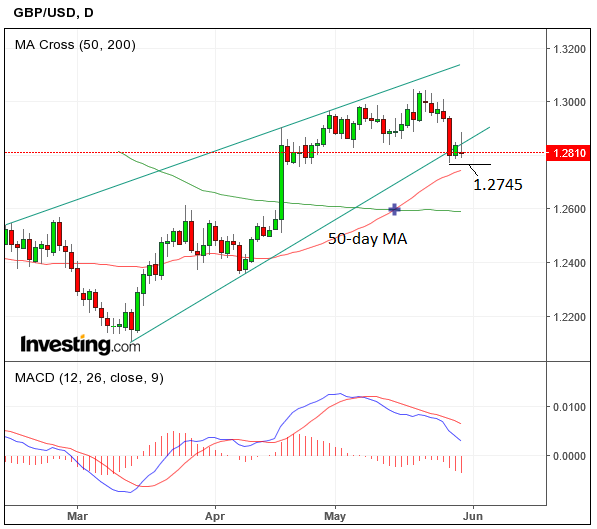Pound to Weaken Against Dollar Again as Undervaluation Predicted to Persist

Pound Sterling traded in a wide volatile range against the Dollar on Tuesday and latest studies suggest a negative tone should persist over the near-term.
The GBP/USD exchange rate rose from a starting point of 1.2800 all the way up to highs of 1.2888 before falling back down to 1.2792 again at the end of the day on the back of a new poll that showed the Conservative party is due to lose power at the General Election which is now just a week away.
GBP/USD now looks poised to resume its dominant short-term downtrend but its scope for further bearish extension may be limited.
A formidable obstacle lies in the way in the form of the 50-day moving average (MA) situated at 1.2742, and whilst the exchange rate looks increasingly like it will get that low it will then probably struggle to break below the MA, and we shall have to re-evaluate our position once it has reached there.

Traders have been reluctant to sell the Pound agressively as it is undervalued on most valuation models.
But the reason for this is to do with the heavy Brexit risk premium it is carrying.
Rather than go away, the risk of a hard Brexit has probably increased recently as the EU and the UK square off ever more antagonistically before the negotiation process begins.
Sterling is likely to remain undervalued, therefore, all other things being the equal until that risk dissipates.
Traders were once heavily 'short' the Pound but positioning data shows this is not the case anymore. To short is to sell in trading parlance, and when we say the market is short the Pound we say the majority of participants in that market are holding bets against the currency.
But recent data, from futures exchanges, no longer shows most positions being bearish as traders start to believe the worst for the currency has come to pass.
Oddly though, when positioning is more neutral, as it is now, it sets the scene for volatility either higher or lower as there is the chance for new entrants to enter the market and push it in either direction.
“The recent rally also appears to have substantially reduced short positioning. The IMM report shows sterling shorts to be at their lowest levels than at any time since the referendum result with leveraged positions close to flat (albeit asset managers remain short),” says a report from Deutsche Bank released May 30.
Whilst the Pound still shows downside potential; the Dollar conversely looks poised to appreciate.
Put simply, the market is just not yet pricing in the potential in the US economy.
Interest rates, for example, are expected to be raised at least three times in 2018 but markets are not expecting more than one hike.
Higher interest rates mean a stronger Dollar as they attract foreign investment which gravitates to countries offering higher returns.
“The Fed is very underpriced,” says Deutsche Bank’s George Saravelos, who notes how, “the market is only pricing one rate hike from the Fed next year compared to a 75bps Fed baseline and at a time when financial conditions are exceptionally easy.”
With hard Brexit fears rising rather than diminishing, and markets probably underestimating the extent of growth in the US economy and the trajectory of interest rates, GBP/USD appears to have a definite bias to losses, in line with our technical studies.





